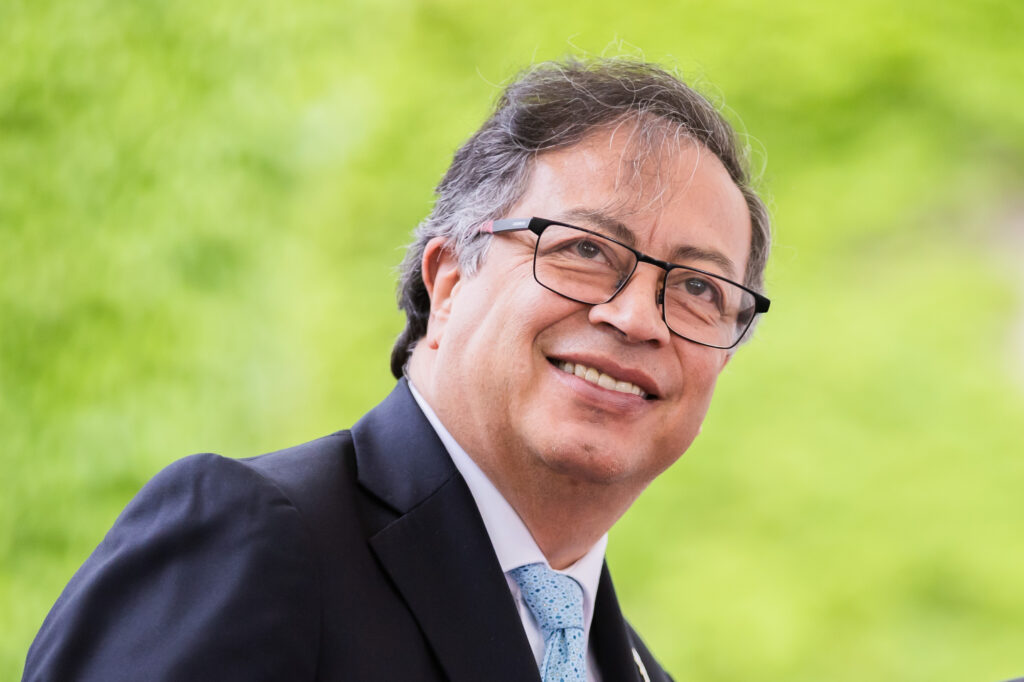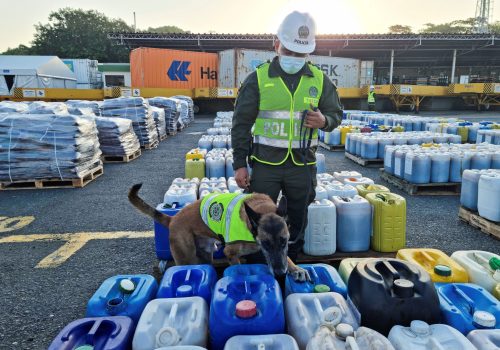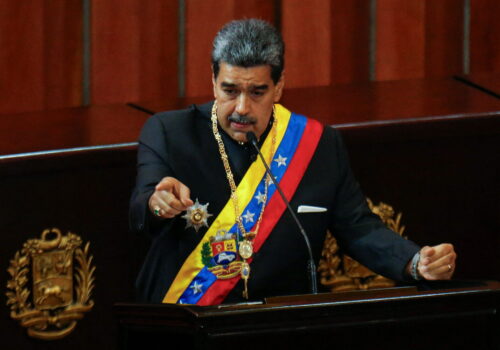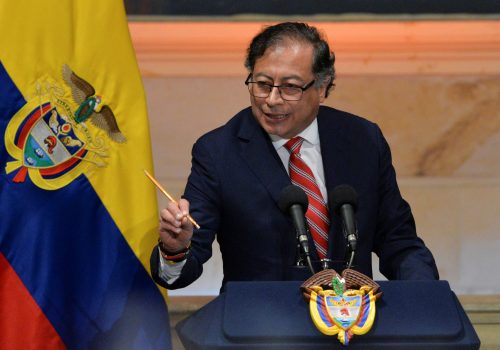Colombian President Gustavo Petro is nearing the midpoint of his four-year term facing stalled progress on his reform agenda and increasing political volatility. Amid these challenges, Petro must adopt a steadier hand on domestic issues and a more cooperative stance toward international private sector investment. This would be a prudent reboot for a politician who is shedding support and sending signals that could sour relations with investors capable of lifting Colombia’s still-recovering economy.
Colombia, a key US security and trading partner in South America, needs to soothe markets and solidify its economic recovery through a mix of political pragmatism, compromise, and a commitment to deepening investment. Economic stewardship is key both to securing reform and long-term development.
Economic challenges
Many Latin American economies have been buffeted in recent years, as the COVID-19 pandemic and Russia’s invasion of Ukraine each took a toll. For Colombia, it was a nearly 9 percent hit to its gross domestic product (GDP) in 2020 and a 13.1 percent rise in consumer prices in 2022. Combined, these factors prompted the previous administration of Iván Duque as well as the Petro administration in its early days (the last quarter of 2022) to adopt a series of countercyclical recovery programs to get the economy back on track.
Colombia’s economy has seen mixed indicators in recent years. On the one hand, unemployment remained at around 11 percent and inflation decreased to 9 percent in 2023, while on the other hand the economy grew only by 1.2 percent, below the Finance Ministry’s forecast of 1.8 percent growth and lagging behind other countries in the region. During 2023, for example, Colombia’s GDP growth was lower than the growth reported by Venezuela (5 percent), Panama (4.6 percent), the Dominican Republic (4.6 percent), Guatemala (3.2 percent), Honduras (3 percent), Costa Rica (2.7 percent), and Nicaragua (2.3 percent). Yet other economic fundamentals, such as the exchange rate, seem to be stabilizing, and interest rates are expected to follow the same trend or move downward. Forecasts for Colombia’s 2024 GDP growth range from 1.3 percent to 1.8 percent, and its annual inflation rate dropped in the first trimester of 2024 but is still among the highest in the region, at 7.4 percent.
Signals to the private sector
This coming August, Petro will hit the halfway point in his four-year term, and he is ineligible to seek reelection. If current trends continue, he will meet that milestone while overseeing lackluster economic growth; failing to advance his stymied health reform while other reform proposals languish in Congress; and facing scrutiny for the implementation of his 2022 tax reform, with aspects of it being challenged in the Constitutional Court.
Petro—who has expressed frustration with the forces impeding his agenda—backtracked from a campaign promise this year. In 2018, Petro literally carved into a marble tablet a list of promises to reassure critics who swore he would take the country down the same path of political extremism and erosion of democracy as Nicolás Maduro in neighboring Venezuela. One “commandment” was to refrain from convening a National Constituent Assembly to revise the country’s constitution. In March, however, he proposed convening a National Constituent Assembly, the first since 1991, to address six different issues that are stalled in the legislature. The proposal is unlikely to proceed given his lack of support in Congress, and any attempt to advance it through decree would be blocked by the courts. On top of this, Petro has lost the support of most Colombians: more than 60 percent of Colombians disapprove of his administration, according to an April 9 survey by Invamer.
Nonetheless, the polarizing constitutional reform proposal has generated further uncertainty about the country’s policy direction and economic expectations, both unwelcome drags on Colombia’s private-sector investment climate. Other issues contributing to concerns in the private sector include a 10 percent decline in imports of goods and services and a 16 percent drop in new business investment. Likewise, the slow disbursement of public spending in many government agencies has raised eyebrows because state spending is the main driver of employment in remote regions, particularly with infrastructure and housing development.
Three steps to shift this dynamic
The conventional wisdom in Colombian politics is that a good economy will help even an unpopular government find a way to advance its agenda with minimal resistance. But in order for this maxim to apply to the Petro administration, the president would need to make some significant changes to shift the current dynamic.
First, he would need to spur more coordination with the private sector to stoke investment and shore up the country’s reputation as a destination for companies. For instance, the government’s reindustrialization program provides an important opportunity, if implemented as planned, to foster cooperation and coordination with domestic and foreign private-sector entities interested in investing in Colombia. This program opens the door for new business ventures in areas that are critical for the country’s development. A good place to start would be for the national government and the private sector to work jointly on incentives that can help quickly spur investment in critical sectors such as infrastructure, tourism, health, digital communications.
Second, Petro would need to build consensus around the reforms he is seeking to advance in Congress. This will be essential to find a way to address Colombia’s most pressing needs—without undoing decades of stable economic and political development.
Third, the president should recognize that the outlook for Colombia’s economy matters to the United States as well. Despite ongoing debate over coca eradication efforts, Colombia remains the closest US ally in the region in the fight against drug trafficking. It is also the leading destination for US agricultural exports in South America and the third-largest in the Western Hemisphere overall, a position that has been secured by a free trade agreement that prioritizes investment in the country.
The US private sector can be an important catalyst in the development of Petro’s reindustrialization agenda. Post-pandemic changes in supply chains open up opportunities to invest in just such a friendly, nearby market. Colombia also has a rising middle class and the expanding consumption that entails, as well as the prospect of new revenue from Colombian exports to neighboring Venezuela and other countries across the region.
The rest of this year will be a crucial test for Petro’s economic stewardship. If managed successfully, he can bolster the country’s growth trajectory. To do so, he will have to both spend public funds wisely and do so in a way that works hand in hand with international investors and with the support of partners such as the United States. The necessary actions will be his to initiate—but the impact of such outreach and development would extend well beyond his term.
Enrique Millan-Mejia is a consultant and project manager at the Atlantic Council’s Adrienne Arsht Latin America Center and a former senior trade and investment diplomat of the government of Colombia to the United States.
Geoff Ramsey is a senior fellow at the Atlantic Council’s Adrienne Arsht Latin America Center.
Further reading
Thu, Nov 30, 2023
Advancing US-Colombia cooperation on drug policy and law enforcement
Report By
Consumption and price of the drug has remained stable in the United States in recent years. However, the current trend of falling coca leaf and cocaine prices in Colombia present a natural incentive for coca growers to find alternative forms of income, which could mean a higher rate of success for alternative development programs.
Thu, Apr 18, 2024
Experts react: The US just reimposed sanctions on Venezuela. What does this mean for energy markets and Venezuela’s election?
New Atlanticist By
The United States will reimpose oil sanctions on Venezuela, faulting Nicolás Maduro’s government for failing to uphold the October 2023 Barbados Agreement.
Mon, Nov 13, 2023
What Colombia’s ambitious new anti-drug plan means for US relations
New Atlanticist By
The Colombian government recently unveiled a new ten-year drug strategy, attempting to break from a half-century of policies that have failed to curb coca production.
Image: Gustavo Francisco Petro Urrego, President of Colombia, arrives at the Chancellor's Office.



